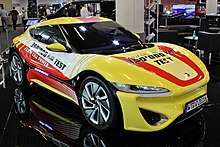NanoFlowcell
nanoFlowcell is a Swiss flow cell battery research and development company.
| Private | |
| Industry |
|
| Founded | 2013 |
| Founder | Nunzio La Vecchia |
| Headquarters | Kilchberg , Switzerland |
Key people |
|
| Products | |
| Services | research and development |
| Parent | nanoFlowcell Holdings Ltd |
| Website | nanoflowcell |
nanoFlowcell claims to have developed the first flow battery small enough to be used in electric cars. Its battery, also branded nanoFlowcell, was first presented in the Quant E, Quant F[1] and Quantino prototype vehicles.[2] Similar to regular redox flow batteries, the nanoFlowcell battery uses electrolyte fluids to generate electricity from chemical compounds. nanoFlowcell claims that, unlike the electrolytes in vanadium flow batteries or polysulfide bromide flow batteries, the electrolyte used in the nanoFlowcell is non-toxic and environmentally compatible. The company claims that the electrolyte used in the nanoFlowcell battery has an energy density of 600 Wh per litre, which is ten times the energy density of regular redox flow cells.[3] nanoFlowcell states that production cost for its "non-flammable and non-explosive" electrolyte is below 10 cents per litre.[4]
The feasibility of nanoFlowcell's promises has been questioned.[5][6][7][8][9]
nanoFlowcell has registered offices in Kilchberg, Switzerland [10] and London, United Kingdom.[11]
QUANT Prototypes

Under the name QUANT (derived from quantum mechanics), nanoFlowcell Holdings is developing applications for its nanoFlowcell battery technology, mainly electric vehicles such as the QUANT E, QUANT FE and Quantino. The Quantino is the latest electric prototype vehicle produced by nanoFlowcell engineers for their battery testing purposes. The road-legal version of the Quantino was first introduced at the Geneva International Motor Show in 2016, together with its more powerful sibling QUANT FE.[12][13]
The Quantino and QUANT FE prototype vehicles have been used for non-public technology presentations towards the automobile industry in 2016 to further demonstrate the use and advantages of flow cell technology in electric cars. Several journalists who drove Quantino and QUANT FE in public testings confirmed functionality of the nanoFlowcell's flow cell technology.[14][8][15] The Quantino allegedly has been using 12 kWh per 100 km in a mixed test.[16]
bi-ION Electrolyte
Similar to regular modern flow cells, nanoFlowcell is producing electricity from liquids. However, the electrolyte is not common salt water as commonly stated in several internet forums, but the electrolyte solution bi-ION consists of a conductive liquid - organic and inorganic salts dissolved in water - and the electrolytes themselves, nano-particles which are specific molecules designed by nanoFlowcell Holdings Ltd. While dissolved redox salts are responsible for the energy transfer in conventional redox flow batteries, the bi-ION electrolyte is an energy storage medium whose suspended nano-particles permit a considerably higher energy density than regular redox electrolyte liquids.[17]
Controversy
Critics claim a lack of scientific understanding or patents describing how water with metallic salts can be used to produce electric energy with the efficiency and energy density that the company claims.[18] The claimed performance seemed to contradict research that has been done on flow batteries.[19] It has been said that "there is no solid proof just yet that the QUANT e actually works and performs as advertised".[20]
The Quant 48 Volt delivers 560 kW at 48 V, with 140 kW going to each motor.[21] This means the current going to each motor is equal to 2917 Amps which would heat up the cable dramatically. The company fails to explain how it is solved. Regarding the propulsion Top Gear concluded: "But while American universities say they find nanoFlowcell’s technology plausible, European institutions have poo-pooed it."[8]
See also
References
| Wikimedia Commons has media related to NanoFLOWCELL Quant e-Sportlimousine. |
- "This is a 1075bhp, 186mph electric car". Top Gear. Retrieved 5 March 2015.
- "nanoFlowcell Quantino Electric Sportscar". Gt spirit. Retrieved 5 March 2015.
- "BI-ION - ENERGY CARRIER FOR THE ELECTRICITY OF TOMORROW". nanoflowcell.com. nanoFlowcell Holdings Ltd. Retrieved 30 March 2017.
- "NanoFlowcell Want To Revolutionize The EV Market With The Quant 48Volt". carbuzz.com. CarBuzz Inc. Retrieved 6 March 2017.
- Clemens Gleich (2015-03-11). "Fantastische Literatur aus Genf: der Quant-Supersportler". Heise Autos. Retrieved 2015-03-17.
- "Nanoflowcell Quantino: Elektrolyt-Stromer für Jedermann?". ecomento.de (in German). 2015-02-19. Retrieved 2019-03-25.
- Online, FOCUS. "4 Euro für 100 Kilometer: Revolutioniert der Flüssig-Akku das Elektroauto?". FOCUS Online (in German). Retrieved 2019-03-25.
- "Review: the nanoFlowcell-powered Quantino prototype". Top Gear. 2016-10-07. Retrieved 2019-03-25.
- Torchinsky, Jason. "The Supercar That Runs Using 'Saltwater' Is Likely Bullshit". Jalopnik. Retrieved 2019-03-25.
- "nanoFlowcell IP AG". moneyhouse.ch. Moneyhouse AG. Retrieved 30 March 2017.
- "nanoFlowcell Holdings Ltd". Companies House. Registrar of Companies (England and Wales). Retrieved 30 March 2017.
- "Geneva 2016: Nanoflowcell Quantino". gtspirit.com. GTspirit Limited. Retrieved 2 March 2016.
- "Quantino and Quant FE as near-production models". plugin-magazine.com. AM Ljubljana. Retrieved 2 March 2016.
- "Revolutionary Flowcell EV could make production". autocar.co.uk. Haymarket Media Group. Retrieved 18 October 2016.
- "Emissionsfreie Reichweite zum Nachtanken". auto-motor-und-sport.de. auto motor und sport. Retrieved 7 October 2016.
- "1,167-Kilometre test drive in the Quantino". Retrieved 31 October 2016.
- http://emagazine.nanoflowcell.com/technology/bi-ion-energy-of-the-future/
- "e-Sportslimousine is a scam". Retrieved 19 October 2016.
- "The Supercar That Runs Using 'Saltwater' Is Likely Bullshit". Retrieved 19 October 2016.
- "Flow Cell Batteries: A Substitute For Lithium-Ion?". Retrieved 19 October 2016.
- "nanoFlowcell's newest concept takes electric mobility to a safer and more efficient level?". Retrieved 12 March 2018.